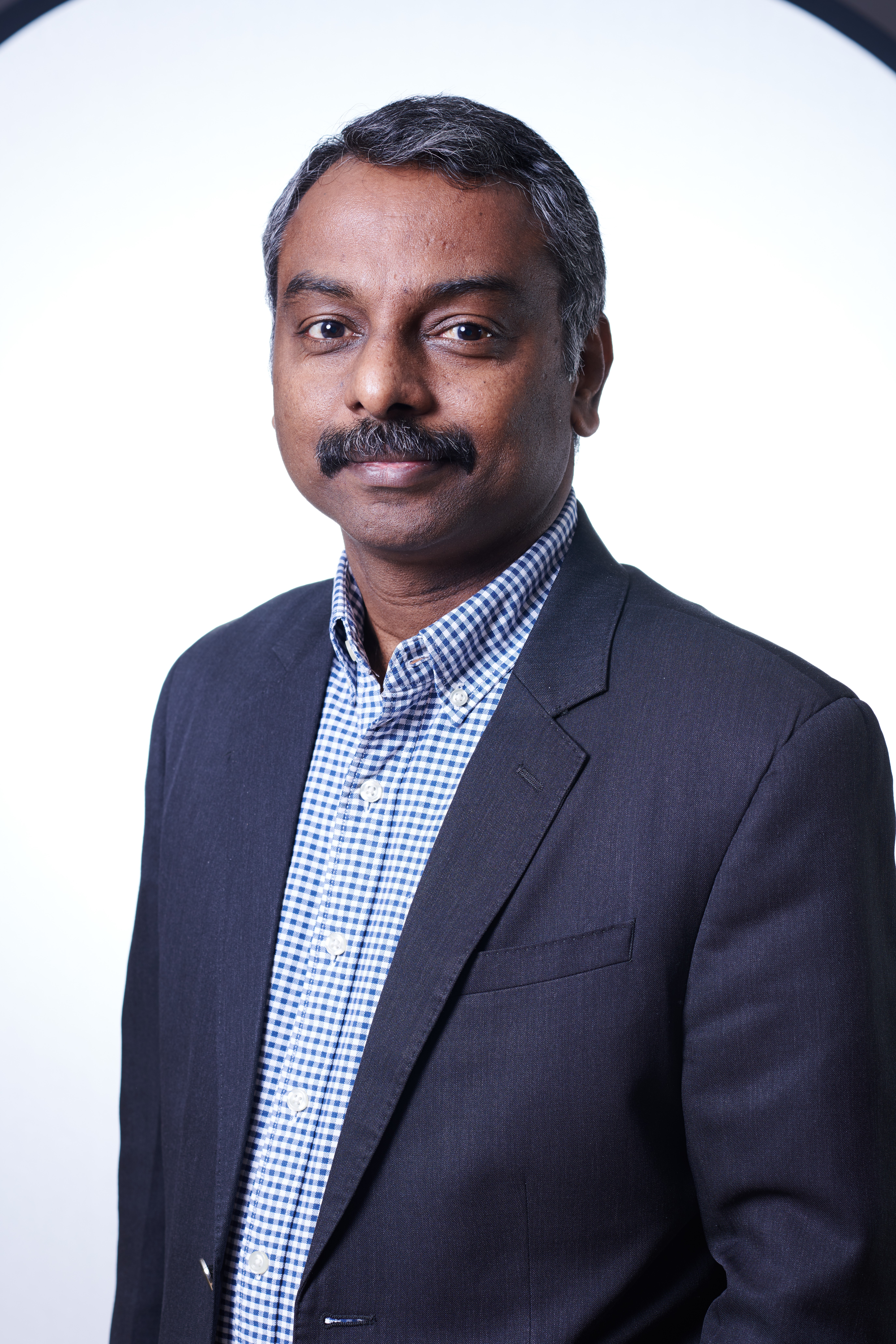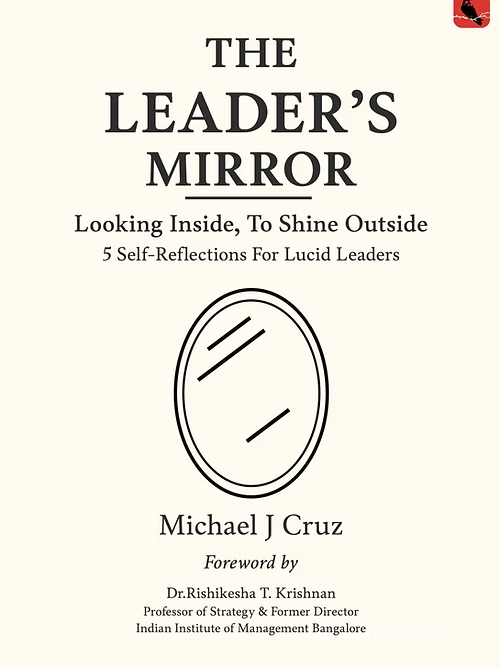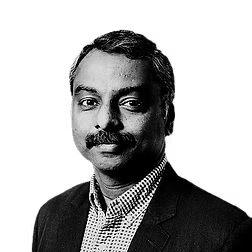Alumni Author: The Leader’s Mirror – Michael J Cruz, EGMP 2010
Michael J Cruz, an IIM Bangalore alumnus and seasoned corporate leader, has spent over three decades shaping businesses across higher education, research, and LegalTech. Today, as an executive coach and author of The Leader’s Mirror: Looking Inside, To Shine Outside, he helps leaders gain self-awareness, navigate complex challenges, and craft their leadership legacy. In this interview, Michael shares insights from his journey, the inspiration behind his book, and the lessons that guide effective leadership today.
Could you tell us a bit about yourself—your background, journey so far, and what drives you personally and professionally?

I started in Sales at Tata McGraw-Hill/ McGraw-Hill Education and built my career over three decades of corporate leadership experience. I drove commercial success across organizations serving clients in higher education, research, and LegalTech.
Over the years, I held various leadership positions before eventually serving as Managing Director of South Asia for two market leaders. First, Emerald Group’s Information Services South Asia business for higher education research.Then as Managing Director and Board Member of RELX PLC’s (FTSE 100 US$ 60 Bn) India LegalTech (AI & Data Analytics) business- LexisNexis Legal & Professional.
Along the way, I learned as much from my mistakes as from my successes. What struck me repeatedly was how often leadership challenges weren’t really about strategy or operations. They were about leaders—myself included—not having clear visibility into our own patterns and blind spots.
That realization led me to transition into executive coaching in 2021. What drives me now is simply being useful to other leaders wrestling with similar challenges. There’s something quite rewarding about sitting with someone who is facing a tough decision and helping them think through it more clearly as their thinking partner. Helping them think it through more clearly feels meaningful.
I’m continually learning from the leaders I work with. Each coaching conversation teaches me something new about the complexities of modern leadership. The experience has made me more aware of how much I still don’t know – helping me to be more curious and grounded.
The Leader’s Mirror is a thoughtful exploration of self-reflection in leadership. What inspired you to write this book, and what key leadership gap were you hoping to address?
Toni Morrison famously said, “If there is a book that you want to read, but it hasn’t been written yet, then you must write it.”
The inspiration came from a simple observation. Many leaders genuinely want to craft a positive leadership legacy. However, they’re struggling to determine their current position in the process. Many senior executives, despite their experience, often feel that they’re making decisions without sufficient clarity about their own leadership patterns.
I noticed this in my own corporate roles. And, I hear it often in my coaching conversations.
As an executive coach, I partner with technically excellent leaders who struggle with questions like, “Why do I keep having the same conflicts with my team?” or “Why do some decisions feel harder than they should?” The issue wasn’t competence. It was self-awareness.
The book emerged from an effort to address this gap with practical tools grounded in established research. The five assessments emerged from real coaching situations. Leaders needed actionable insights into their own patterns. I tested these with the executives I work with. They seemed helpful enough that it felt worth sharing more broadly.
The book exists because other people were generous with their time and trust. The leaders I’ve coached are the real authors. I’ve captured what we learned together in a format that others might find helpful.
Who is The Leader’s Mirror aimed at? What kinds of readers or leaders do you believe would benefit most from the insights shared in the book?
Honestly, I wrote it for leaders like the ones I coach. Senior executives who are skilled at their jobs but sense they could be more intentional about their leadership approach. CEOs, Managing Directors, and folks in the C-suite are dealing with complex situations and multiple stakeholders.
It’s particularly relevant if you’re at an inflection point. You may be in a new role. Going through organizational change, or just feeling like your current approach isn’t working as well as it used to.
The book may also be helpful if you’re curious about your own leadership patterns. If you want to start with introspective self-analysis in a safe, non-judgmental space.
The assessments are industry-agnostic and work across most leadership contexts. Whether you’re running a startup or a traditional company, the questions are universal. Decision-making, values alignment, and risk appetite are common challenges everywhere.
It’s most helpful for leaders who are ready to challenge themselves and strive to bring their best version every day. Those who want to become more self-aware and need some structure for taking that awareness to the next level.


What sets The Leader’s Mirror apart from other leadership books, and how can readers make the most of it in their personal or professional growth?
What makes it different is that it’s more personal and practical than theoretical. The assessments came from actual coaching conversations. Based on established research, they address real situations leaders face.
Think about long road trips. We’re careful to check all the key gauges of our vehicle—fuel, coolant, engine oil, and air pressure. We make sure everything is alright. In our leadership journey, what are the key indicators we need to monitor? How do we calibrate them to suit our individual journey?
There’s a lot of literature on leadership. Everyone wants to be a great leader. The journey starts with understanding where we truly are. And what we need to look at. The book provides you with a sense of where you are in your unique leadership journey.
I used a flight deck metaphor because it seemed helpful in thinking about leadership. You need reliable instruments to navigate, especially when things get complicated. However, its five assessments help you identify patterns in your leadership style.
To get the most value, I’d suggest taking all five assessments first. Then look at Chapter 8 to see how they connect. The fundamental insight often arises from recognizing patterns across various areas, not from focusing on any single assessment.
The main thing is to approach it as a starting point for reflection. Not as definitive answers. Leadership is too complex for any book to capture completely. However, these tools may help you ask more effective questions about your own approach.
The book presents several powerful self-reflections. Could you share one insight from The Leader’s Mirror that has had a significant impact on your own approach to leadership and decision-making?
One assessment that really caught me off guard was the Fast & Slow Decisions Profile. Based on Kahneman’s work on how we think and make decisions.
I discovered that I was relying too heavily on analytical thinking, which Kahneman refers to as System 2 thinking. During my corporate years, this thorough analysis served me well in some situations, such as complex turnaround situations. But I realized I was sometimes over-analyzing decisions that might have benefited from quicker, more intuitive responses.
The insight wasn’t just about being faster or slower; it was about being more efficient. It was about being more intentional about when to use which approach.
In my coaching practice, I aim to help clients develop what I call “decision triggers.” Simple guidelines for determining when a situation requires quick pattern recognition versus in-depth analysis.
It’s made me more aware of my own tendencies. Effective leadership often means being willing to adapt your natural style to meet the requirements of the situation. That’s been the most significant personal takeaway from writing the book. Seeing my own patterns more clearly.
Can you tell us about your writing style and the kind of work or ‘homework’ that went into bringing The Leader’s Mirror to life? What was the most challenging or rewarding part of the process?
I wrote it using a coaching approach. Conversational and practical rather than academic.
The most challenging aspect was applying concepts from psychology and management theory and then making them simple enough to be useful for busy leaders. How do you capture something complex like executive decision-making into an assessment? The content went through dozens of iterations as I used it in my coaching practice. Getting that balance right took time.
I was fortunate to have thoughtful people review early drafts. They asked tough questions that definitely improved the book. Having external editors review the content was beneficial. They ensured the content met editorial standards and was publish-worthy. I aimed for a balance of rigor, relevance, and research that respects my readers’ intellect, while ensuring it sufficiently challenges them.
The most rewarding part has been hearing from leaders who’ve used the assessments and found them helpful. That’s really the only measure that matters. It helps people think more clearly about their leadership approach.
It’s not how much time you spend with the book that matters. It’s how much time you spend with yourself after you read it. This book will help readers spend more time with themselves to craft their unique and impactful leadership legacy.
I feel that writing this book has shown me the mirror about my own writing skills- I have a great opportunity to improve the way I write and communicate my thoughts.
How do you see mindfulness, self-awareness, and mental strength shaping effective leadership in today’s complex and fast-changing business environment?
These qualities are becoming more critical. Simply because the environment in which leaders operate has become more complex and fast-moving.
We’re in a VUCA world—a world that is being upended by the most consequential technology rollout in human history: AI and its easy access to everyone. When there’s more ambiguity, volatility, and pressure, it’s easier to make reactive decisions. Or fall into patterns that don’t serve us well.
Self-awareness helps because if you understand your own tendencies, you can be more intentional. Where do you tend to rush versus where you over-analyze? What values actually drive your decisions? Understanding this helps you respond rather than react.
Mindfulness, even in small doses, creates space to pause. You can check your approach before making important decisions. It’s not about meditation retreats or anything elaborate—just the ability to step back briefly. Ask yourself whether your response is appropriate for the situation. Are the choices we make aligned and fit for purpose? Are they fit for the future?
Mental strength comes from having clarity about what you’re trying to achieve and why it matters. Leadership resilience and grit are built upon this foundation. When we can lean on our values and calibrate the compass to the right direction, we can persevere. Leaders who regularly reflect on their purpose and values appear to weather difficulties more effectively. They make more consistent decisions under pressure.
The leaders I work with who invest time in this kind of self-reflection tend to be more sustainable in their roles. More thoughtful in their decision-making. But it requires ongoing attention. It’s not something you figure out once and then forget about. There is no silver bullet, unfortunately, that you can fire once and forget.
As an IIM Bangalore alumnus, how did your time at the institute influence your thinking around leadership, personal growth, and your professional journey?
My time at IIMB had a significant influence on my thinking around leadership. It expanded my personal growth and accelerated my professional journey.
What’s unique about our alma mater is that it provides a space for us to be ourselves. At the same time, it gives us the opportunity to expand our thinking. All the professors who taught us—from Prof. Narayanasamy to Prof. Rishikesha—valued our innate abilities. And they always challenged us to expand our thinking.
It was intense and enjoyable. But what made it even more enjoyable was our cohort. The combination of the faculty’s sage wisdom and the cohort’s collective knowledge was powerful. It helped us learn and achieve more. The friendships formed on campus continue to be cherished.
The institute’s emphasis on developing “change agents” resonated with something I’d observed in my own work. Sustainable change usually starts with individuals being willing to examine their own assumptions and behaviors first.
I’m grateful to be part of the IIMB community. I’m honored and grateful that the book was well-received enough to earn a foreword from Professor Rishikesha Krishnan.
The institute’s focus on continuous learning shaped my belief that leadership development is an ongoing process. I am currently learning Japanese Language, Culture, and conversation at the Mizhou India Japan Study Centre of IIMB, continuing my learning journey with the institute.
After The Leader’s Mirror, what’s next for you in the world of writing? Are you working on another book or any new projects we should look forward to?
I’m toying with a couple of thoughts at the moment. The response to this book has been encouraging. There might be value in exploring some related topics.
One area I often find myself thinking about is how leaders navigate contradictions, such as balancing stakeholder demands with personal values and or driving change while maintaining stability. These kinds of paradoxes frequently arise in coaching conversations. How can I write about the practical ways to think through them?
I’ve also wondered about writing something more focused on specific topics. Like active listening or leadership transitions. The early days in a new role or leading through significant organizational changes. These situations have their own patterns and challenges.
But for now, I’m mainly focused on my coaching practice. Continuing to learn from the leaders I work with. Every conversation teaches me something new. I suspect that’s where the next writing project will come from, if there is one.
The writing process taught me that the best books come from real problems that real people are trying to solve. So I’ll continue to listen to what leaders are struggling with and see if there’s something useful I can contribute to those conversations.
Michael’s journey highlights the importance of reflection, mindfulness, and curiosity in leadership. The Leader’s Mirror provides practical tools for leaders to gain self-awareness, make intentional decisions, and grow sustainably. His story reminds us that leadership isn’t just about strategy—it’s about understanding ourselves, learning continuously, and bringing our best to every challenge.
Grab a copy of The Leader’s Mirror: India | Amazon US | Amazon UK


